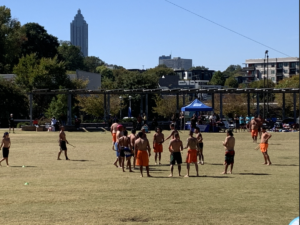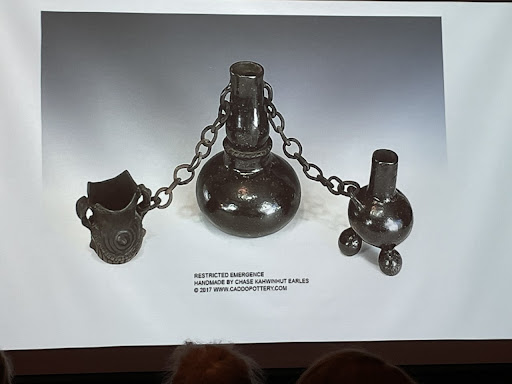
The Southeast Woodlands Stickball Summit Exhibition Game took place on October 15th at the Historic Fourth Ward Activities field along the Atlanta Beltline. Related to the modern game of lacrosse, Native American stickball (toli) is one of the oldest sports in North America.
Visitors to the Activities Field were greeted by the newly installed sculpture of two Chickasaw toli sticks created by event co-organizer Addison Karl entitled Itti’ Kapochcha To’li’.
The October 15 Stickball Summit brought together Cherokee, Choctaw, Chickasaw, and Muscogee communities to play their traditional sport on Muscogee land for the first time in two centuries. The first game played was the Chickasaw version of stickball. The object of the game was to hit a fish on the top of a pole in the center of the field. It is a social game: players were broken into men and women teams of which anyone could join to play. Teams encircled a 15-foot pole to throw the ball up to turn the fish. Second was the Choctaw version. In this variation, each team has a goalie to defend their side’s pole and the offense players attempt to hit the top of the 10-foot pole of the other team. Players threw the ball over longer distances to cross the field while others centered around their pole to protect it. The last game played followed Cherokee rules. Their version was in set teams of nine and the first team to twelve points (passing the goal line) won. This game consisted only of men, and they play barefoot wearing only athletic shorts so their full body is connected to the earth. Wrestling is important in this version as this was the most tactile form to release aggression built over disputes. At the end of the game, all players purified themselves with water to wash away their dispute and resume peace.
Later the same day, the Carlos Museum at Emory University hosted a panel discussion. It began with a documentary of women reclaiming stickball within the Cherokee community. Afterwards, a youth delegation from the Boys and Girls Club of the Mississippi Band of Choctaws performed the Snake Dance in full regalia. This led into the discussion led by Dr. Natalie M. Welch, Ph.D. (Eastern Band of Cherokee Indians), Addison Karl (Chickasaw/Choctaw), Casey Bigpond (Mississippi Band of Choctaw), Ace Greenwood (Chickasaw/Cherokee), Tosh Welch (Eastern Band of Cherokee Indians), and Dr. Monte Randall (Muscogee Nation). They spoke of their connection to stickball and how impactful it was to play with each other in brotherhood. It ended with wisdom and strengths each panelist gained through stickball and how they pass it onward to future generations.
Atlanta Beltline sponsored the 2022 Stickball Exhibition with the Native American and Indigenous Studies Initiative and the Carlos Museum.


